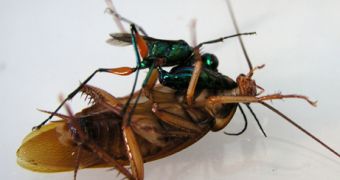There's no Voodoo or tetrodoxin neurotoxin from pufferfish involved in this case. And these Zombies will surely die eaten alive.
In a new research published in the "Journal of Experimental Biology", Israeli researchers have found how the parasitic jewel wasp manages, through a venom injected directly into a cockroach's brain, to eliminate the prey's free will. The wasp's toxins appeared to shut down octopamine, a chemical controlling the motivation for walking in the cockroach's brain.
Devoid of control, the "zombie" roach can be herded by the parasitoid wasp into its subterranean nest, where a wasp egg is injected into its abdomen. The hatching larva will start to eat its living "meat can", which cannot react, from the inside out.
"The whole thing takes about seven to eight days, during which the meat has to be fresh. If you kill a cockroach, it rots within a day." said co-author and neurobiologist Frederic Libersat, of Ben-Gurion University of the Negev, in Be'?r Sheva, Israel. One month later a mature wasp emerges from the roach's mummy. Octopamine is a brain chemical that turns insects alert, making them move and accomplish demanding physical activities.
"It serves the same functions as noradrenaline, which is involved in the fight-or-flight reaction ... in the vertebrate brain," said Libersat.
The wasps were found to insert their venom into the roach's protocerebrum, the brain nucleus containing octopamine-secreting neurons.
The team could reverse the venom's action: by injecting an octopamine-like chemical directly into the protocerebrum of the zombie roaches, the free will of the insects was significantly restored.
"This helps us understand how movement is initiated in animals," said Libersat.
There are many parasites changing the behavior of their hosts, but only these parasitoid wasps directly target the host's brain using toxins. For example, snails and ants parasited by worms start standing on the top of the leaves of grass. This way, the snails are eaten by birds continuing the life cycle of the worm, while the ants are swollen by cows, for their parasite life cycle. Also, fishes parasited by tapeworms swim to the water surface, so that they can be eaten by water birds, which also get infected, and so on.

 14 DAY TRIAL //
14 DAY TRIAL //